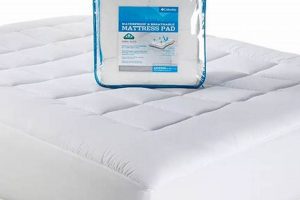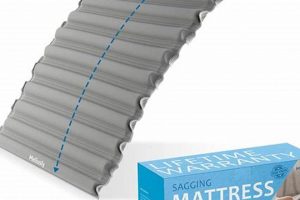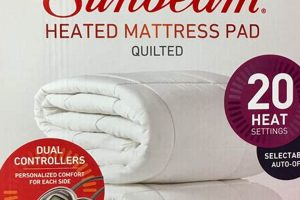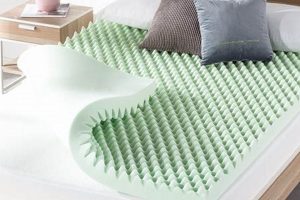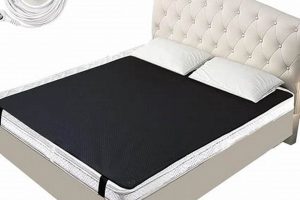These bedding accessories are designed to enhance the comfort and support of a mattress. Typically constructed with a layer of gel-infused material, they are placed atop a standard mattress to modify its feel. For example, one might add such a pad to a firm mattress to introduce a softer, more conforming surface.
The incorporation of gel is significant due to its potential to regulate temperature and distribute weight. This can lead to improved sleep quality by minimizing pressure points and reducing overheating during the night. Historically, advancements in sleep technology have focused on materials that enhance both comfort and thermal regulation, and these pads represent a tangible outcome of that progression.
The subsequent sections will delve into the specific materials used in these products, analyze their impact on sleep quality, and provide a guide for selecting the most suitable option based on individual needs and preferences. Consideration will also be given to maintenance and longevity factors.
Gel Mattress Pad Selection and Maintenance Tips
The following tips are designed to assist in the informed selection and proper maintenance of gel-infused mattress enhancements, thereby maximizing their benefits and extending their lifespan.
Tip 1: Consider Density and Thickness: A higher density typically indicates greater support and durability. Thicker pads offer more cushioning, but may alter the feel of the underlying mattress more significantly. Evaluate individual comfort preferences and existing mattress characteristics when making this determination.
Tip 2: Evaluate Gel Distribution: The method of gel infusion impacts performance. Uniform distribution promotes consistent temperature regulation, while zoned configurations may offer targeted support. Examine product specifications to understand the specific gel distribution pattern.
Tip 3: Assess Breathability: While gel can aid in temperature regulation, the cover material and overall construction influence breathability. Opt for materials like cotton or bamboo, known for their ventilation properties, to prevent heat buildup.
Tip 4: Check for Motion Isolation: Some pads enhance motion isolation, minimizing disturbances from a partner’s movements. If co-sleeping, consider this feature for improved sleep quality.
Tip 5: Follow Cleaning Instructions Carefully: Proper cleaning is essential for hygiene and longevity. Adhere strictly to the manufacturer’s instructions, which may involve spot cleaning or professional laundering. Avoid harsh chemicals that could damage the gel.
Tip 6: Use a Mattress Protector: A waterproof mattress protector beneath the pad shields it from spills and stains, prolonging its lifespan and maintaining its cleanliness.
Tip 7: Rotate Regularly: While not always necessary, rotating the pad periodically can help distribute wear and prevent indentations, especially if one area is consistently subjected to greater pressure.
Adhering to these guidelines will contribute to the optimal utilization and long-term performance of gel-infused mattress enhancements, ensuring a more comfortable and supportive sleep environment.
The final section will provide a comprehensive summary of the advantages and disadvantages associated with these products, allowing for a balanced and informed decision-making process.
1. Cooling Properties
The inclusion of gel in mattress pads is frequently associated with enhanced thermal regulation, aimed at mitigating heat retention during sleep. This association stems from the material properties of certain gels, which exhibit a greater capacity for absorbing and dissipating heat compared to conventional mattress materials such as polyurethane foam. The cause-and-effect relationship is such that the gel layer acts as a thermal buffer, drawing heat away from the sleeper’s body and distributing it across a wider surface area. The effectiveness of this mechanism is directly proportional to the gel’s thermal conductivity and the pad’s overall breathability. For instance, a gel-infused pad with a breathable cotton cover will generally exhibit superior cooling performance compared to one with a non-breathable synthetic cover.
The practical significance of understanding the cooling properties lies in selecting appropriate sleep products tailored to individual thermal needs. Individuals who experience nocturnal overheating, often referred to as “hot sleepers,” may find substantial relief through the utilization of gel-infused mattress pads. Furthermore, the type of gel employed significantly impacts the overall cooling effect. Phase change materials (PCMs), a subset of gel technologies, offer a more pronounced cooling effect due to their ability to absorb and release heat as they transition between solid and liquid states. Examples include pads incorporating Outlast technology, initially developed for NASA to regulate temperature in spacesuits. These pads actively manage temperature fluctuations, preventing the buildup of excessive heat.
In conclusion, the cooling properties imparted by gel within mattress pads represent a critical functional attribute, particularly for individuals susceptible to overheating during sleep. The effectiveness of these properties is contingent upon the specific gel type, material composition, and overall design of the pad. Addressing the challenge of heat retention necessitates a comprehensive understanding of these factors, enabling informed consumer choices and the optimization of sleep comfort. Future research may explore advanced gel formulations and ventilation strategies to further enhance the cooling capabilities of these bedding accessories.
2. Pressure Relief
Pressure relief is a critical function of bedding, directly influencing sleep quality and musculoskeletal comfort. Gel-infused mattress pads are frequently marketed based on their ability to mitigate pressure points, thereby enhancing sleep and reducing discomfort. Understanding the mechanisms by which these pads achieve pressure relief is essential for discerning their potential benefits.
- Conformability and Weight Distribution
Gel materials possess viscoelastic properties, allowing them to conform to the body’s contours. This conformability distributes weight more evenly across the surface, reducing concentrated pressure on bony prominences such as hips and shoulders. For instance, a side sleeper may experience reduced shoulder compression and improved spinal alignment due to the pad’s ability to adapt to the body’s shape. The implication is a decrease in pressure-related pain and an improvement in overall sleep comfort.
- Viscoelastic Response and Hysteresis
The viscoelastic nature of gel means it deforms under pressure and gradually returns to its original shape when the pressure is removed. This delayed response, known as hysteresis,
contributes to pressure relief by slowly adjusting to changes in sleeping position, minimizing abrupt shifts in pressure. Consider the scenario of a sleeper shifting from their back to their side; the gel pad’s gradual adjustment cushions the transition, reducing the likelihood of pressure-induced awakenings. - Gel Density and Support
The density of the gel influences its ability to provide both pressure relief and support. Low-density gel may offer excellent conformability but insufficient support for heavier individuals, potentially leading to bottoming out and increased pressure. Conversely, high-density gel may provide adequate support but reduced conformability, diminishing pressure relief. The ideal density strikes a balance between these two factors, accommodating a range of body weights and sleeping positions. For example, a medium-density gel pad may suit a wider range of individuals compared to extremely low- or high-density options.
- Thermal Regulation and Pressure Sensitivity
Gel’s thermal properties can indirectly affect pressure relief. Elevated temperatures can increase the pliability of some gel types, enhancing their conformability and pressure-relieving capabilities. However, excessive heat can also degrade the material over time, reducing its effectiveness. Proper ventilation and breathable cover materials are crucial for maintaining optimal temperature and preserving the gel’s structural integrity. A pad with inadequate ventilation may become uncomfortably warm, potentially increasing pressure sensitivity and discomfort.
These multifaceted aspects of pressure relief, when considered in the context of gel-infused mattress pads, highlight the complexity of achieving optimal sleep comfort. The interaction between material properties, density, and thermal regulation ultimately determines the pad’s effectiveness in mitigating pressure points and promoting restful sleep. Understanding these connections enables consumers to make informed choices based on their individual needs and preferences.
3. Density Variation
Density variation in gel-infused mattress enhancements is a critical factor influencing support, pressure relief, and overall product longevity. Density, measured as mass per unit volume, directly affects the firmness and responsiveness of the material. A higher density typically translates to increased support and resistance to compression, while lower density offers enhanced conformability and pressure redistribution. The causal relationship between density and performance is such that selecting an inappropriate density can negate the intended benefits of the gel infusion.
The practical significance of density variation becomes apparent when considering different user needs. Individuals requiring robust support, such as those with higher body weights or those who prefer a firmer sleep surface, benefit from higher-density gel. For instance, a gel mattress pad with a density of 5 pounds per cubic foot will generally provide more substantial support than one with a density of 3 pounds per cubic foot. Conversely, individuals seeking maximal pressure relief, such as those with joint pain or sensitivity, may find lower-density options more suitable. A real-world example is the use of lower-density gel pads in hospitals to prevent pressure ulcers in bedridden patients. The effectiveness of the pad is therefore contingent on aligning the density with the individual’s specific requirements.
In conclusion, density variation represents a fundamental design parameter in gel mattress pad construction. Understanding the impact of density on support, pressure relief, and durability is essential for informed consumer decision-making. Challenges remain in achieving optimal density for diverse body types and sleep preferences, necessitating continued research and development in material science and product engineering. Recognizing this link allows for a more tailored and effective approach to enhancing sleep comfort and mitigating pressure-related discomfort.
4. Material Composition
Material composition is a primary determinant of performance, durability, and safety in gel mattress pads. The types of materials used, their proportions, and their interaction directly influence the pad’s ability to provide comfort, regulate temperature, and withstand wear. Careful consideration of these factors is vital for both manufacturers and consumers.
- Gel Infusion Medium
The gel itself is embedded within a carrier material, often polyurethane foam or memory foam. The quality and density of this medium impact the pad’s overall support and resilience. For instance, a high-density memory foam infused with gel will generally provide more support and conformability than a low-density foam. The choice of medium is a fundamental design decision affecting the product’s core characteristics.
- Cover Fabric
The fabric encasing the gel-infused layer plays a significant role in breathability and moisture management. Materials such as cotton, bamboo, or specialized synthetic blends promote airflow and wick away moisture, enhancing cooling properties and preventing the buildup of humidity. A cover made of non-breathable material, such as vinyl, can negate the cooling benefits of the gel and lead to discomfort.
- Adhesive Components
Adhesives are frequently used to bond different layers of the pad together, such as the gel-infused layer to the support foam or the cover fabric. The type and quality of adhesive can impact the pad’s structural integrity and its potential for off-gassing. Non-toxic, low-VOC adhesives are preferable to minimize potential health risks.
- Flame Retardants
In compliance with safety regulations, many mattress pads incorporate flame retardant materials. These can include chemicals applied to the fabric or inherent properties of the foam itself. The type and concentration of flame retardants vary, and some consumers may prefer pads that utilize less controversial or naturally derived flame retardant options.
The interplay of these components determines the overall performance of gel mattress pads. The selection of materials represents a trade-off between various factors, including cost, comfort, durability, and safety. Understanding these elements enables consumers to make informed choices aligned with their individual needs and preferences.
5. Thickness Options
Thickness options in gel mattress pads directly affect the degree of comfort and support modification provided to the existing mattress. A thicker pad will generally offer more cushioning and a greater alteration of the underlying mattress’s feel, creating a softer surface. Conversely, a thinner pad offers a subtler change, primarily influencing temperature regulation and minor pressure relief. This relationship is crucial: an inadequately thick pad may fail to deliver the intended comfort enhancement, while an excessively thick pad can negatively alter the intended support characteristics of the mattress. For example, adding a 4-inch pad to an already soft mattress could create an unstable and unsupportive sleeping surf
ace, leading to discomfort or even back pain. The practical significance of understanding thickness options lies in appropriately matching the pad’s profile to the individual’s needs and the existing mattress characteristics.
Furthermore, thickness influences the pad’s effectiveness in isolating motion and dissipating heat. A thicker gel layer can potentially absorb more movement, reducing disturbances from a sleeping partner. Similarly, a greater volume of gel may provide a more substantial cooling effect, especially when combined with breathable cover materials. The increased material, however, can also impact the pad’s overall weight and ease of handling. For instance, a thicker pad may be more difficult to install and remove for cleaning. Selecting the appropriate thickness involves a balance between desired comfort and practical considerations, such as ease of use and maintenance.
In summary, the thickness of gel mattress pads is a critical design element influencing comfort, support, motion isolation, and thermal regulation. A well-considered thickness enhances these desired characteristics, while an inappropriate choice can negatively impact sleep quality. Addressing challenges regarding comfort customization and heat regulation requires a thorough understanding of thickness options, ultimately ensuring that the product aligns with individual requirements and optimizes sleep experiences.
6. Longevity Factors
The lifespan of gel mattress pads is governed by a complex interplay of material properties, usage patterns, and maintenance practices. Several key factors contribute to or detract from the durability and extended usability of these bedding accessories. Understanding these factors is essential for consumers seeking to maximize their investment.
- Material Degradation
Gel-infused materials, particularly memory foam, are susceptible to degradation over time due to oxidation and compression. Repeated pressure and exposure to air can cause the gel and surrounding foam to lose its resilience and supportiveness, leading to permanent indentations and reduced comfort. The quality of the materials used in the pad’s construction directly influences the rate of this degradation. For example, higher-density foam generally exhibits greater resistance to compression and deformation compared to lower-density alternatives. This material fatigue is an inevitable process, but its progression can be mitigated through proper care and usage.
- Moisture Accumulation
Gel mattress pads, especially those lacking adequate ventilation, can trap moisture from perspiration and ambient humidity. This moisture accumulation fosters the growth of mold and mildew, which not only compromises hygiene but also accelerates the breakdown of the pad’s materials. The presence of mold and mildew can weaken the foam structure and cause unpleasant odors, significantly reducing the pad’s lifespan. Utilizing a breathable mattress protector and ensuring adequate ventilation in the sleeping environment can help prevent moisture buildup. For example, frequently airing out the bedroom can reduce humidity levels and minimize the risk of microbial growth.
- Improper Cleaning Practices
Aggressive cleaning methods and harsh chemicals can damage the gel and foam components of mattress pads, shortening their lifespan. The use of strong detergents, bleach, or abrasive scrubbers can degrade the materials, causing them to lose their integrity. Moreover, improper drying techniques, such as using high heat, can warp the foam and diminish its pressure-relieving properties. Adhering to the manufacturer’s recommended cleaning instructions is critical. For instance, spot cleaning with a mild detergent and allowing the pad to air dry in a well-ventilated area is generally preferred over machine washing or drying.
- Weight Distribution and Support Base
Uneven weight distribution and an inadequate support base can accelerate the wear and tear on gel mattress pads. If the pad is placed on a sagging or unsupportive mattress, it will be subjected to increased stress and compression, leading to premature deformation and reduced effectiveness. Ensuring that the underlying mattress provides adequate support is essential for maintaining the pad’s integrity and extending its lifespan. Regularly rotating the pad can help distribute wear more evenly and prevent localized compression. This is analogous to rotating tires on a vehicle to prolong their usable life.
These longevity factors underscore the importance of selecting high-quality materials, adopting appropriate cleaning and maintenance practices, and ensuring a stable and supportive foundation for gel mattress pads. Addressing these considerations can significantly extend the lifespan of these bedding accessories and maximize their value.
Frequently Asked Questions
The following addresses common inquiries regarding the functionality, maintenance, and selection of gel mattress pads. The information provided is intended to clarify misconceptions and offer objective guidance.
Question 1: How does gel infusion enhance mattress pad performance?
Gel infusion serves primarily to improve temperature regulation and pressure distribution. The gel material facilitates heat dissipation, reducing overheating during sleep. Additionally, it conforms to body contours, alleviating pressure points. The degree of enhancement varies based on gel type, density, and overall pad construction.
Question 2: What is the expected lifespan of a gel mattress pad?
The lifespan is contingent on material quality, usage patterns, and maintenance. A high-quality pad, properly maintained and subjected to moderate use, may last between three to five years. Frequent use, improper cleaning, or inferior materials will reduce this lifespan.
Question 3: Are gel mattress pads suitable for all types of mattresses?
Gel mattress pads are generally compatible with most mattress types, including innerspring, memory foam, and latex. However, the specific combination should be evaluated based on individual comfort preferences and support needs. A pad placed on an already soft or unsupportive mattress may exacerbate issues rather than resolve them.
Question 4: What are the recommended cleaning procedures for gel mattress pads?
Cleaning procedures vary depending on the manufacturer’s instructions. Spot cleaning with a mild detergent is generally recommended for minor stains. Machine washing is discouraged unless explicitly permitted by the manufacturer, as it can damage the gel and foam components. Air drying is preferable to machine drying.
Question 5: Do gel mattress pads contain potentially harmful chemicals?
Some gel mattress pads may contain volatile organic compounds (VOCs) or flame retardants that are of concern to some individuals. Opting for pads certified by organizations such as CertiPUR-US or OEKO-TEX can minimize exposure to these chemicals. Reading product labels and researching manufacturer practices is advised.
Question 6: How does gel density influence the pad’s performance?
Gel density affects the firmness and support provided by the pad. Higher-density gel offers greater support and resistance to compression, while lower-density gel provides enhanced conformability and pressure relief. The optimal density depends on individual weight and sleeping position preferences.
The key takeaways from these frequently asked questi
ons emphasize the importance of informed selection, proper maintenance, and realistic expectations when considering gel mattress pads. Understanding these aspects can contribute to a more satisfying purchase and improved sleep quality.
The next section will summarize the advantages and disadvantages, offering a concise overview for decision-making.
Conclusion
This examination has provided an overview of gel mattress pads, exploring their composition, functionality, and associated considerations. Key aspects, including material density, cooling properties, and maintenance requirements, have been addressed to provide a comprehensive understanding of these bedding accessories. The objective has been to equip individuals with the knowledge necessary to make informed purchasing decisions, aligning product selection with specific needs and preferences.
The efficacy of gel mattress pads ultimately hinges on individual circumstances and adherence to recommended care practices. While these products can offer potential benefits in terms of temperature regulation and pressure relief, they are not a universal solution for sleep-related issues. Continued research and innovation in sleep technology are essential to address the evolving needs of consumers and optimize sleep quality. The responsible and informed use of gel mattress pads remains crucial for maximizing their potential and mitigating potential drawbacks.


